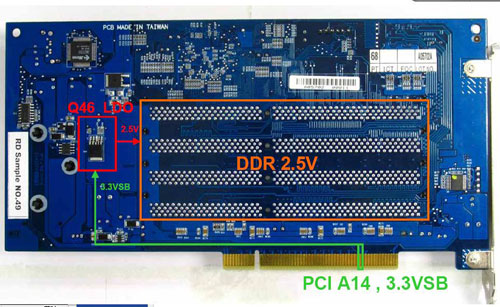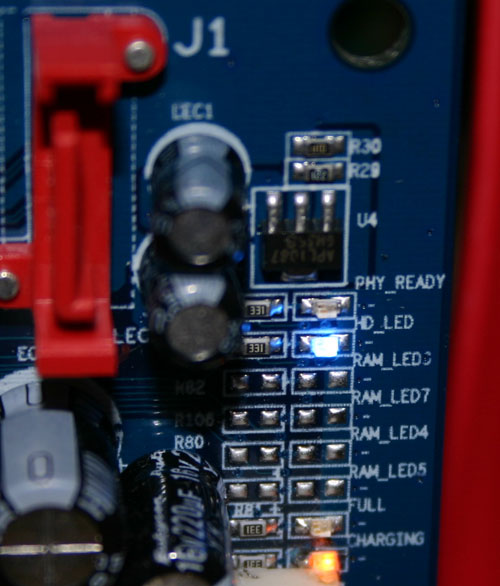Gigabyte's i-RAM: Affordable Solid State Storage
by Anand Lal Shimpi on July 25, 2005 3:50 PM EST- Posted in
- Storage
i-RAM's Limitations
Since your data is stored on a volatile medium with the i-RAM, a loss of power could mean that everything stored on the card would be erased with no hopes for recovery. While a lot of users may keep their computers on 24/7, there are always occasional power outages that would spell certain doom for i-RAM owners. In order to combat this possibility, Gigabyte outfitted the i-RAM with its own rechargeable battery pack.
There are only three conditions where the i-RAM runs off of battery power:
1) When the i-RAM is unplugged from the PCI slot;For whatever reason, unplugging the i-RAM from the PCI slot causes its power consumption to go up considerably, and will actually drain its battery a lot quicker than the specified 16 hours. We originally did this to test how long the i-RAM would last on battery power, but then were later told by Gigabyte not to do this because it puts the i-RAM in a state of accelerated battery consumption.
2) When the power cable is unplugged from your power supply (or the power supply is disconnected from your motherboard; and
3) When the power button on your power supply is turned off.
For the most part, the i-RAM will always be powered. Your data is only at risk if you have a long-term power outage or you physically remove the i-RAM card.
If you run out of battery power, you will lose all data and the i-RAM will stop appearing as a drive letter in Windows as soon as you power it back up. You'll have to re-create the partition data and copy/install all of your files and programs over again.
The card features four LEDs that indicate its status: PHY_READY, HD_LED, Full and Charging.











133 Comments
View All Comments
Aganack1 - Monday, July 25, 2005 - link
i thought they said that they were only going to make 1000. enought for the crazies who have money to burn...P.S. if any of you crazies are reading this i could burn some of that money for you... just let me know.
Houdani - Monday, July 25, 2005 - link
Thanks for running through the multiple roles for which the iRam might be useful. I'm rather surprised it wasn't MORE useful in the benches. I'd be interested in learning (i.e. slacking back and reading the results of someone else's research) why the i-Ram is still as large a bottleneck as it is. Yes it's faster than the HD, but why isn't it much, much faster? Are we seeing OS inefficiency or something else altogether?In the end, though, it doesn't fit my needs particularly well, so I'll pass this round. Maybe a future version will be more appealing in terms of cost, speed, size.
Sunbird - Monday, July 25, 2005 - link
maybe the SATA interface isn't fast enough?pio!pio! - Monday, July 25, 2005 - link
I'm constantly shuffling 1--3 gb mpeg2 files around...this would be greatGed - Monday, July 25, 2005 - link
Would it be possible for an NVIDIA or ATI graphics card that used TurboCache or HyperMemory to make use of the i-RAM?That might be interesting.
Anton74 - Monday, July 25, 2005 - link
No, absolutely not. Even if it were, the SATA interface is *way* too slow to be of use for something like that.And even if that were not a factor, why spend that kind of money on the i-RAM where the same amount would buy a *much* superior video card with its own dedicated memory?
Anton
kleinwl - Monday, July 25, 2005 - link
I think that this would be very helpful as a page file for workstations. Older workstations may be maxed out with 4GB and windows 2000 (which the company does not want to move over to xp-64) and still need additional ram for CAD/CFD/etc. This would be an easy upgrade with a reasonable amount of performance increase.sandorski - Monday, July 25, 2005 - link
Was hoping it would offer more, especially as a Pagefile. Any plans to make a PCI-e version(IIRC PCI-e has a ton more bandwidth than SATA), that would likely make this a Must-have. As it stands now I'd only use it for the silence in a HT Setup.Gatak - Monday, July 25, 2005 - link
Using PCI/PCI-e for transfers would require OS drivers which wouldn't be available for all OSes.sprockkets - Tuesday, July 26, 2005 - link
Keep in mind that for many years the ide/sata controllers are NOT on the PCI bus of the southbridge, so PCI is not a limitation.